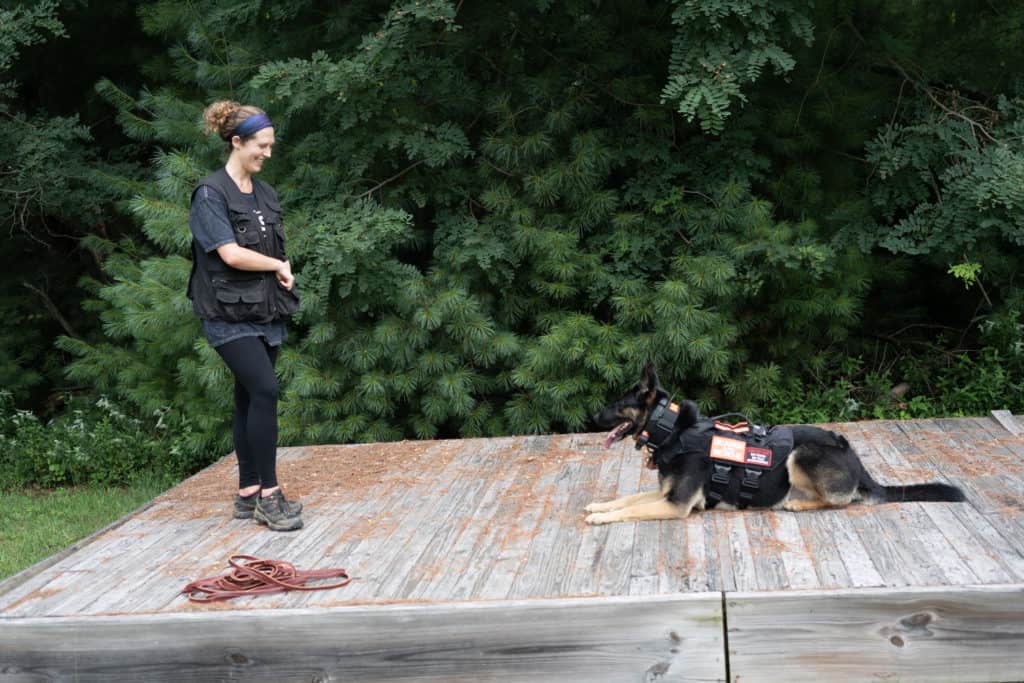Little in life is as frustrating as putting effort into your dog training regimen only to achieve minimal to no progress. From obedience training to detection, dog training requires a solid plan and plenty of action to be successful. So why is it that sometimes we work with our dog and still don’t see the notable improvements which we expected?
You may be familiar with the quote, “Life is a marathon, not a sprint.” This is certainly true with many things in life – including dog training. Dog training may look a bit different for everyone, but there are definitive ways to maximize the amount of progress that you make over time.
One sometimes overlooked factor necessary for maximizing dog training results is consistency. Consistency is incredibly valuable in dog training – and for a number of reasons which you may not immediately consider.
What is consistency in dog training?
According to the Cambridge Dictionary, consistency is defined as, “The quality of always behaving or performing in a similar way, or of always happening in a similar way.” In dog training, consistency is important in a number or ways and for a variety of reasons.
When reviewing how to maximize consistency in dog training, there are a few aspects that we must consider.
Consistency in schedule
If we are not consistent with our training schedule, it will be very difficult to achieve steady improvements in our dog’s capability or behavior. Training schedule consistency does not mean that you have to train your dog at the same time every day (although this can be helpful in the beginning stages of learning), it just means that working on your skills regularly will help you make more progress than if you just work on them once every couple of weeks.

Consistency in our cues
Although humans learn to understand language and the meaning of words, dogs often respond to the tone of our voice and our body language. If we are trying to teach a dog to sit, for example, and sometimes we recite the cue “sit” in a high, excitable tone while using an exaggerated hand gesture, and then other times we say “sit” in a low, flat tone while our arms are crossed, our dog may believe that we are asking for two separate behaviors entirely.
Marker tools such as clickers work incredibly well in teaching many animal species because they create a highly consistent sound and are paired consistently with a reinforcer. An animal rapidly learns through consistency that when they hear the “click,” whichever behavior they are exhibiting will eventually warrant a reinforcer. Cue consistency is critical for training success, from the handler’s actions preceding the cue, to the cue itself. Remember that the physical cues which we exhibiting with our body language are as important to maintain as the verbal cue itself.
Consistency in following a training strategy
One of the biggest mistakes that many pet dog owners make is giving up on a training technique before it has had time to work. Learning does not occur in a linear fashion, and oftentimes significant amounts of foundational skills are required before the brain can accurately process more complex skills. If we try a particular technique for one, two or three days and only see a minuscule amount of progress, it can be easy to believe that the technique is not working. This is not always the case, however, and many times more time is required for a method to be effective. In cases of attempting to change established behaviors (such as through behavior modification), it can take much more time to see results.
In addition to this, behavioral work often requires the use of minuscule incremental adjustments to make progress. If an owner or trainer attempts to jump ahead too quickly, they risk suffering significant behavioral setbacks, frustration (both for the human and dog), or a lack of progress entirely. Just as with exercise, it is important to find a plan and stick with it for a while before deciding if it is working or not.

Consistency in expectations
Before any training session, it is important to have a plan and an objective for that session. Prior to deciding on this, however, you must first have a very clear idea of what you are trying to teach. Once you have decided on this end result, it is imperative to work backwards and separate the final desired behavior into small, manageable steps (also known as “successive approximations”).
When you have decided on how these successive approximations will look, consistency in your expectations for the dog is critical. Say, for instance, you are trying to teach a dog to ring a bell. If you are expecting the dog to ring the bell with their muzzle but occasionally prefer them to paw at it, they will learn the skill much more slowly because there is inconsistency in handler expectations.
Consistency in environment
In the beginning stages of learning, it can be very important to have a consistent training environment. Consistency in your training environment minimizes external variables which could be distracting or could influence your dog’s attention or learning.
Since the “cue” which your dog learns actually contains a number of factors including tone of voice, body language and anything else which may be consistently occurring in the environment immediately prior to the behavior being performed, it can hasten learning if your environment remains consistent at first.
When training, your objective should be to control as many antecedents as possible. An antecedent is any stimuli which occur or appear right before a behavior is exhibited. By controlling the antecedents in your dog’s environment, especially in the beginning stages of learning, you can set them up for success by minimizing the chances that they will make a mistake. Once your dog understands your cue and the expected behavior, you can systematically begin working with them in other environments which will enable them to generalize any desired behaviors.
Why is consistency in dog training important?
Consistency in dog training is crucial for dog training success because it sets expectations and allows a dog to learn at the pace which is best for them. As previously noted, learning does not occur in a linear fashion. If you stop working with a dog because you don’t feel that they are making enough progress, there is a good chance that you will miss one of the “eureka!” moments which accompanies the natural learning process. Dogs, like many other species, are always learning. Learning does not immediately equate to action or a change in behavior, because many things need to occur in the brain before an animal demonstrates consistent physical responses.
If you are following a specific training protocol or plan and you are seeing gradual progress, it is likely worth maintaining even if results don’t seem to be happening as quickly as you’d like. Unfortunately, there has been an influx in dog trainers releasing video content demonstrating dogs during their ‘before’ and ‘after’ stages. These videos can make it seem like progress occurred rapidly and like you are doing something incorrectly if you’re not seeing rapid progress too. In reality, many of these behaviors required many intermediate stages and quite a bit of time and dedication to accomplish.
If you find yourself constantly switching techniques because you don’t feel as though progress is occurring quickly enough, you will likely find that the dog begins appearing frustrated, rebellious, disinterested or unmotivated. Confusion often accompanies frequent switching of protocols when trying to train one specific behavior. Even though it may not be obvious to us, many protocols contain aspects which conflict with other protocols. Since a dog who is still learning does not yet understand the desired outcome, conflicts in training techniques will sabotage progress and frustrate your dog.
How can I make my dog training more consistent?
Now that we understand the nuances of consistency in dog training and why it is important, we can cover how to implement improved consistency within your own dog training strategies. Consistency is imperative for success, and by focusing on each individual aspect of your training strategy and making concrete decisions regarding the best way to optimize each of these factors, you can avoid the inconsistency that accompanies indecisiveness.
Take a look at all of the factors mentioned previously: schedule, cues, strategy, expectations and environment. Visualize what you want them to look like, and then write that vision down. It is important to be realistic and patient, and to look for small signs of improvement instead of significant leaps forward.
Make dog training a priority – even if you can only offer five minutes per day to your dog’s learning, add that to your schedule and stick to it. Five minutes per day is more than 150 minutes per month, and more than 1,800 minutes per year. Think of how much you could accomplish with your dog in 1,800 minutes!
Just like with any longterm goal, you must be able to break the final result into many smaller parts. If you want to achieve maximum consistency in your dog training, understanding what these “smaller parts” look like and striving for small wins instead of huge triumphs will help you feel happier with your progress. Ultimately, this approach will result in optimal long-term outcomes.

